Welcome to our section on Russian Dwarf Hamster Care.
In this section we will look at what environment your hamster needs, which bedding, foods, toys, cleaning processes/equipment, handling and general care of your Russian Dwarf Hamster.
This is the ultimate guide to Russian Dwarf Hamster Care, to skip to what you’re looking for please click the buttons below.
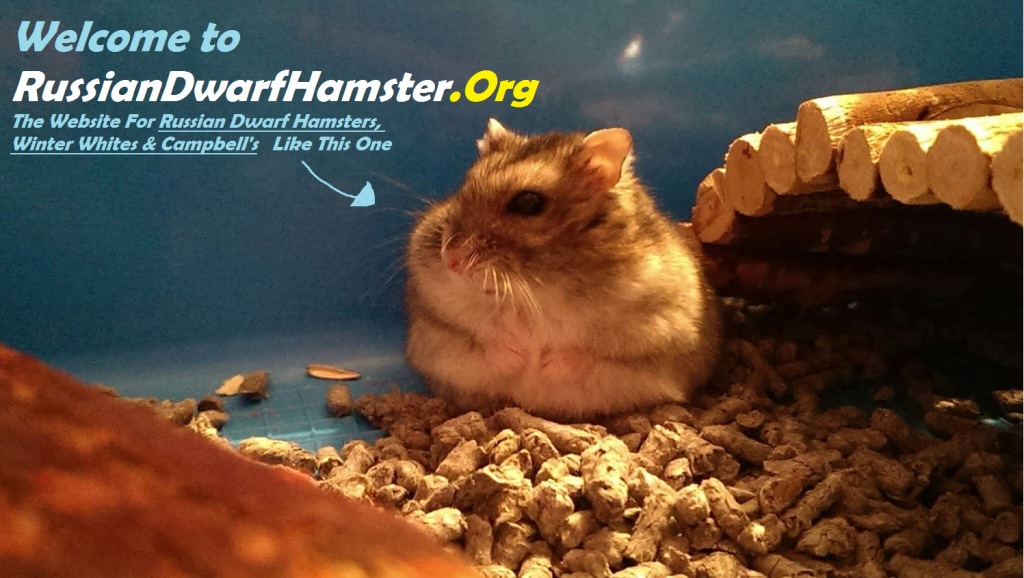
- Russian Dwarf Hamster Diet
- Handling Russian Dwarf Hamsters
- Exercise For Your Russian Dwarf Hamster
- 3 Little Known Tips to a Happy Russian Dwarf Hamster
- Cleaning Out Russian Dwarf Hamster Cages & Routines
- Choosing The Best Cage For Your Russian Dwarf
Firstly and most importantly your hamster needs the correct environment to live a happy healthy life. The cage must be kept in a dry environment away from direct sunlight and drafty areas. This is essential for a happy hamster.
Bedding
Russian Dwarf Hamsters love to create nests and burrow in their cages. When setting up your Hamster cage, bedding will soak up their litter and provide comfort.
See the video below showing the basic layout for a Russian Dwarf Hamster environment.
There are two types of materials that are needed for the home of your Russian Dwarf. These are sawdust, wood shavings or paper pellets (if you’re allergic to dust, paper pellets are best) for the bottom of your cage and suitable nesting materials like tissue paper and toilet paper.
Your hamster will make its own nest with toilet paper and generally prefers this over pet store alternatives… That’s a tip that will save you loads of money.
Bedding should be absorbent, soft and non-harmful if eaten by your hamster.
Cotton wool material types should be avoided for nesting as this can get stuck in their cheeks and harm your hamsters.
Russian Dwarf Hamster Diet
What should my Russian Dwarf Hamster eat?
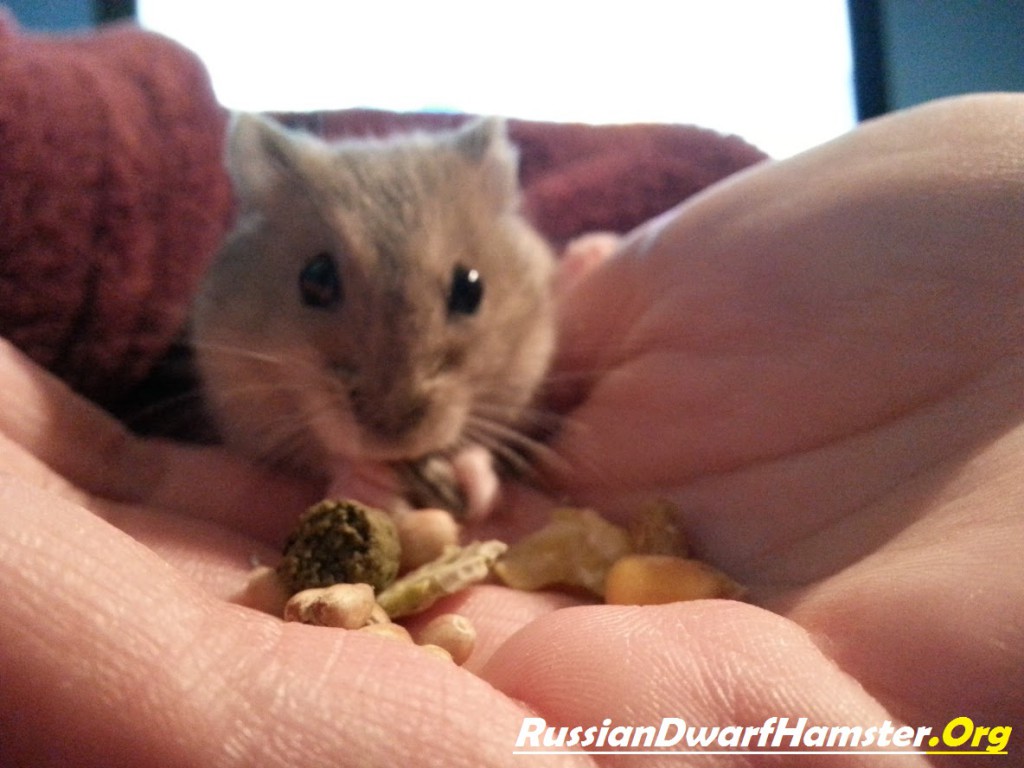 Commercial hamster foods can be bought in most pet stores, these usually contain seeds, nuts and some mixes even contain dried meal worms. Each Dwarf hamster should only need one or two teaspoons a day of these mixes.
Commercial hamster foods can be bought in most pet stores, these usually contain seeds, nuts and some mixes even contain dried meal worms. Each Dwarf hamster should only need one or two teaspoons a day of these mixes.
Important note: Fresh water should be available at all times.
Can my Hamster Eat Fruits or Vegetables?
Small amounts of fruits and vegetables can be given once a week for variety and extra vitamins for your Russian Dwarf Hamsters (make sure these are washed thoroughly to remove any chemicals or pesticides which could upset their bellies).
What Can Russian Dwarf Hamsters Eat? Some examples of friendly fruits and vegetables are:
| Apple | Asparagus | Avocado (skinned and stone removed) | Banana |
| Basil | Blueberries | Cauliflower leaves & stalks | Broccoli |
| Celery | Chestnuts | Cherries (stones removed) | Coriander |
| Carrots | Cucumber | Grapes (seedless) | Figs |
| Mint | Kiwi Fruit | Kidney beans (cooked) | Mango |
| Raspberries | Sage | Strawberries | Sweetcorn |
Important note: Russian Dwarf Hamsters are prone to diabetes and because fruits are high in sugars, it’s better to give them vegetables.
However some fruits and vegetables that should be avoided are:
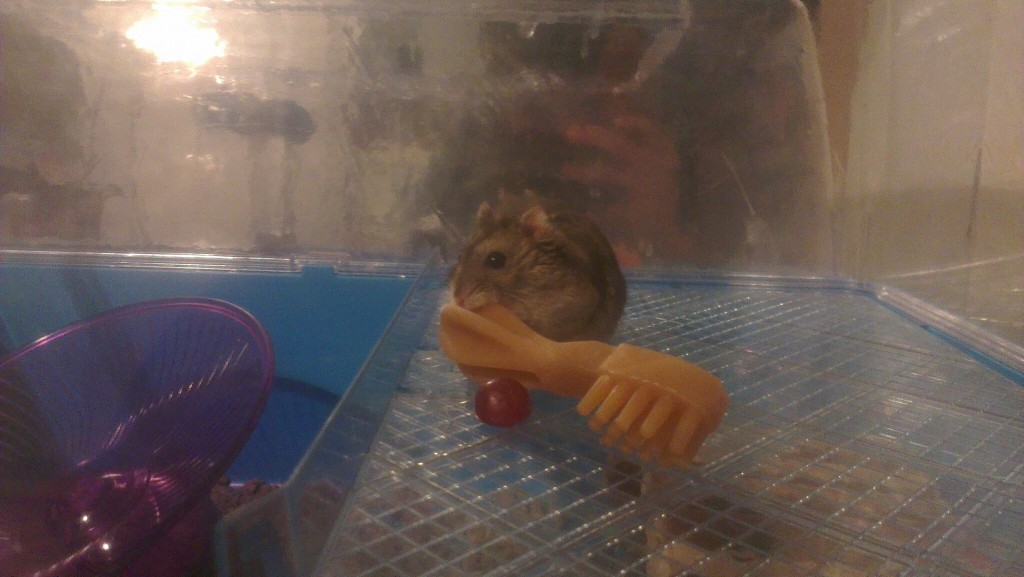
- Onion
- Potato
- Tomato Leaves
- Rhubarb & leaves
- Raw Kidney Beans
- Mouldy Fruits & Vegetables
What Else Can I Feed my Hamster?
Small amounts of cooked chicken or hard boiled egg whites can be given once a week for extra protein (especially for pregnant hamsters, see page on hamster breeding for more info) and for a healthy hamster.
Treats and Chews
Hamsters love to chew! Providing enough chewies is highly advised, this gives them some entertainment, something tasty to chew and is also great for their teeth.
They can have soft rawhide chews (these are normally sold for dogs – see picture of my hamster Hubert, with his rawhide toothbrush) and they also love to chew on wooden items. Special hamster treats are great and they love them, however they are only treats so don’t feed them too many to avoid obesity and diabetes.
Important note: A sudden change in a hamsters diet can cause diarrhea and should be avoided. Please introduce new foods in small amounts day by day with their current food.
Mineral Blocks
Mineral blocks are not really necessary if your Hamster has a well balanced diet, but they do sometimes like to chew on them.
Mineral licks and blocks generally last for months if not years depending on how much your hamster enjoys them. They are really cheap and worth having as an extra accessory for your Russian dwarf hamster.
Handling Russian Dwarf Hamsters
If you want to get to know your Russian Dwarf and play with them, you’ll need to handle them at least once a day in the beginning weeks. Hamsters enjoy being handled and this will help build a happy relationship with your hamster that will last.
The most common errors people do with hamsters is put their fingers/hands in front
Handling your hamster once a day will help your hamster become used to your presence and touch. If you put your hands underneath they normally will climb onto your hand. See the video tutorial below of Russian Dwarf Hamsters faces. This can result in a nip or a bite from your hamster, because they think your hand could be food or a foe. Always pick Russian Dwarf Hamsters up from underneath like you would scoop water with 2 hands.
What To Do If Your Hamster Nibbles Or Bites – All types of hamsters nibble and bite. This is thier way of distinguishing whether what is in front of them is edible. That’s how they learn. There are two types of biting, here is how to distinguish one from the other:
Nibble: A Small bite that doesn’t hurt but is noticeable is known as a nibble and is not meant to hurt you but tasting you and realizing who you are. This is friendly and you should avoid flinching or sudden movement that may scare your Russian Dwarf.
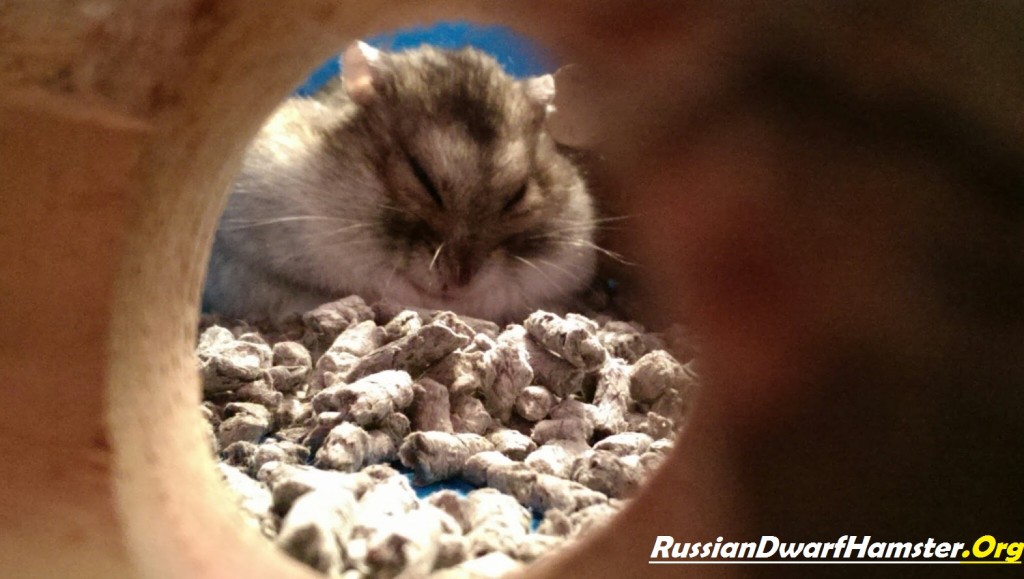 A Warning Bite: This sounds worse that it is and if happens to you, don’t worry. This generally means that your dwarf hamster feels scared, stressed or not handled enough. Hamsters are forgetful and if not handled within a couple of days they can feel threatened and bite.
A Warning Bite: This sounds worse that it is and if happens to you, don’t worry. This generally means that your dwarf hamster feels scared, stressed or not handled enough. Hamsters are forgetful and if not handled within a couple of days they can feel threatened and bite.
The difference between a Warning Bite and a nibble is that a warning bite is faster and your hamster may make a noise of distress. Please see Russian Dwarf Hamsters Fighting for more info on the noises Russian Dwarfs make.
Just remember to use two hands when picking them up and handle regular and biting should not happen.
Exercise for your Dwarf Hamster
Exercise is important for dwarf hamsters because it keeps them fit, healthy, happy, energized and entertained.
But what are the best ways to keep your hamster fit and healthy? The simple answer is an exercise ball.
An exercise ball is a hollow ball that your hamster goes inside and operates from the inside. They are a great way to let your hamster run around in a safe environment. However, for no longer than 30 minutes ball time. This is because Russian Dwarf Hamsters need regular water and the toilet. Also the airflow inside the ball becomes more restricted after longer periods of time.
Get your hamster ball today (Now 11% off) Click Here
Wheel
Almost all cages that can be purchased online or at your local pet store should include a wheel for exercise of your hamster. Russian Dwarfs hamsters among all types of hamsters love to run in a wheel. A good accessory if your cage does not contain a wheel is this click here.
Helpful tip: A helpful tip for wheels that are louder or not spinning as much as they used too is to Vaseline the joints. Apply a small amount of Vaseline between the wheel and middle spinner to help quieten wheel noises whilst increasing the speed and ease. This will make your wheel spin like new again.
3 Little Known Tips to a Happy Russian Dwarf Hamster
Here are 3 tips that will keep your Russian dwarf hamsters happy, entertained and friendly towards you and all human contact:
Tip 1 – A hamster life in a cage, surrounding or environment can become a bit boring after time. A great easy way to keep your hamster happy and occupied in its surroundings is by changing (moving) their toys, bedding areas, food bowls and accessories around after cleaning out their environment. This will make it special for them and different which will lead to reduced biting bars, chewing plastics and chances of overweight hamsters.
Tip 2 – Hamster love little surprises and excellent cheap way to happy hamsters is by hiding bits of food, fruit, vegetables, tissue paper or treats in between their toys. By giving them something to find later will be like us finding bags of money around the house to hamsters. “Ooo money”
Tip 3 – If you handle your dwarf hamster regularly and let them run around, change their experience every now and then. Hamster love change, let others play with them or put them in their ball in a different room. Please note that hamster do not like change to their home when they have settled in. For example 2 days after they receive new bedding and water, you move everything around again. Russian Dwarf Hamsters do not like this so avoid if you can.
Russian Dwarf Hamsters love to find tissue paper hidden around. In this video, see how to give them a treat of tissue paper.
Cleaning Out Russian Dwarf Hamster Cages & Routines
All hamsters are genuinely similar when it comes to the routine of cleaning out their environment and cages. Once a week, put your hamster in the ball and clean out their cage by emptying all old bedding, nesting materials and water.
You do not need to bin food, chewies for mineral blocks. Simply remove them first the put them back in after.
How to easily clean your hamster cage fast – What we do for our male Russian dwarfs is place hamsters in their exercise balls, empty all old bedding, nesting (tissue) and remaining food into a bin bag. Once this is done, all plastics are sprayed with special anti bacterial hamster cleaner, turn the shower on and adjust the shower head to the most powerful water flow available. Using the shower we thoroughly rinse out the base of the cage, tubes and toys making sure all antibacterial spray is removed. Then simply dry everything with a towel and rebuild cage.
Hamster cages should be cleaned out once a week and not with your hamster still in the cage.
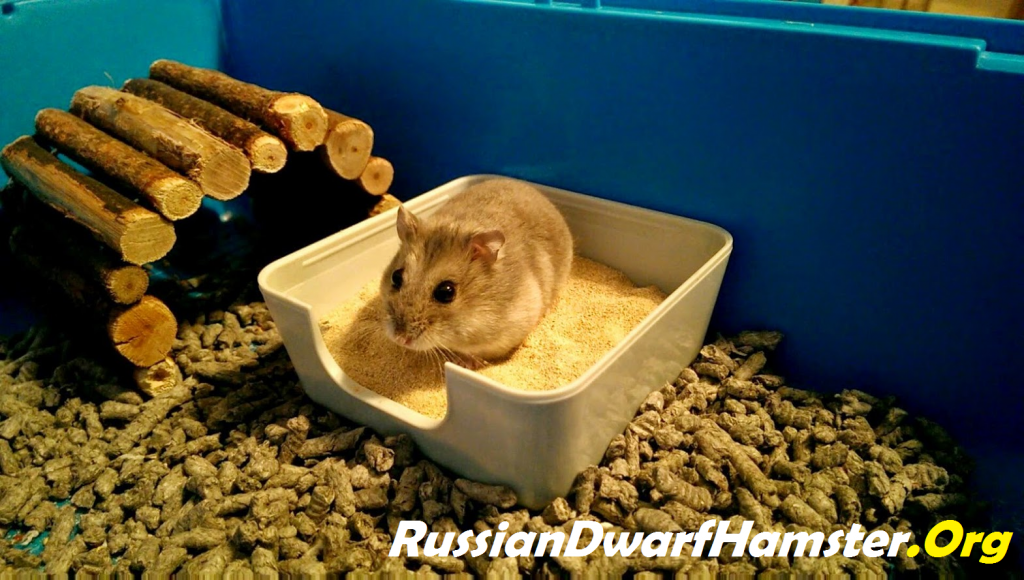
Once cleaned, replace all bedding, foods and water with new stuff. Remember to put back the old mineral blocks, chews and treats from before.
Choosing the Best Cage for Your Dwarf Hamsters
When it comes to choosing the best cage for your beloved Russian dwarf(s) it may be hard to decide. Here are some things that a good Russian Dwarf Hamster Cage should include:
- Space – Space to run, play and roam is very important. Although you will not need a huge cage like you may for a larger hamster like a Syrian, the bigger the better. See what we recommend (Best Russian Dwarf Hamster Cage -See Our Review)
- Layers – This is not essential however will keep your hamster fit and provide more space for toys and accessories. Most hamster cages come with 2 layers (bottom and raised platform) for extra space to play and nest.
- Tubes & available attachments – Having a cage that comes with extra tubes, accessories and essentials can save you a lot of money and time. See Our Review For An Example Of This.
Best Type Of Hamster Cage
There are a few dwarf hamster cages to choose from but what is the best type of hamster cage?
The best types of hamster cages you can purchase online are the ones that come with all of the essentials needed for caring for your dwarf hamster. These include a water bottle, food bowl, a good wheel and of course room to run around. This should be the standard.
After that is checked of you should pick a cage with tubes and at least 2 layers. This gives your dwarf hamster more places to go and dwarf hamsters love tunnels/tubes. To see what cages we recommend to get an idea, please see our Best Cage for Dwarf Hamsters Review.
Final Thoughts
Hamsters are friendly pets to have and should always be cared for correctly. In our Russian Dwarf Hamster Care section, we hope that we have helped you. Please follow us on Google+


Love you site! This is the place I come to when I need help for my 3 Russian Dwarf Hamsters.
I told my friend about you too and she added you on Google+
My name is Natalie btw.
Thanks!
I love this site, very easy to navigate and extremely informative ..
I am rescuing a dwarft hamster from someone that should not be caring for him any longer. I don’t want him to be lonely though, can I introduce another dwarf hamster to him?…how old?
Hi Jonathan, welcome to RussianDwarfHamster.Org
That is very kind of you to rescue a dwarf hamster. If it is a Russian, Campbell’s or Winter White dwarf hamster they may be able to live with a friend however many dwarf hamsters prefer to live on their own and still will be happy/happier.
You should never put two different species to live together (E.g. a Chinese dwarf hamster and a Russian dwarf hamster.)
It is best to introduce two dwarf hamsters at a younger age however not always will the get along unless certain steps are taken place. Have you see our How To Introduce Two Dwarf Hamsters Together?
You can see it at https://russiandwarfhamster.org/how-to-introduce-two-russian-dwarfs-together-5-easy-steps/ That will help you greatly!
In terms of age you generally want to introduce two between the ages of 3-12 weeks and by using the 5 steps to success above you should be fine. Just be careful and observe their behaviour towards each other as you do not want any injuries.
One last thing
As he is a male he most probably will be very territorial and you may find it harder to introduce with a new friend. Males like to play fight and they can turn on one another without any signs or warnings. Please see our How To Introduce Two Russian Dwarf Hamsters and thanks for visiting!
If you need anything else, just ask 🙂
http://RussianDwarfHamster.Org